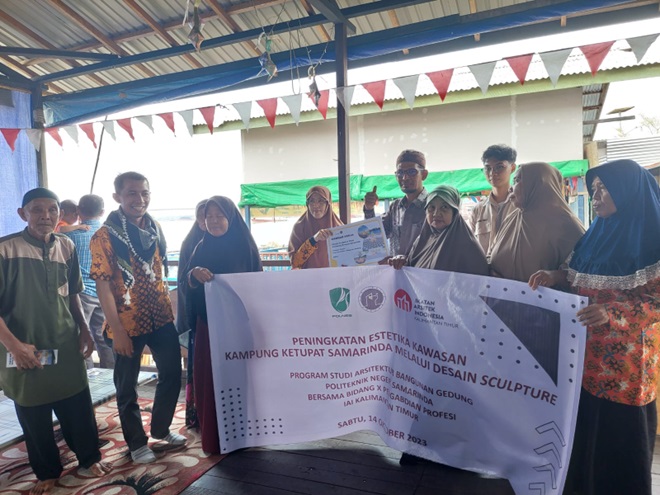Peningkatan Estetika Kawasan Kampung Ketupat Samarinda Melalui Desain Sculpture Improving the Aesthetics of Kampung Ketupat Samarinda Through Sculpture Design
Main Article Content
Abstract
Kampung Ketupat, located in the District of Samarinda Seberang - Samarinda, has been a tourist destination since 2017. Kampung Ketupat is one of the old villages in Samarinda located along the Mahakam River, consisting of stilt houses made from ironwood. Many of its residents are artisans who make 'ketupat' (woven palm leaf pouches for rice) containers sold in Samarinda and the surrounding areas. As time passes, facilities such as sculptures in Kampung Ketupat gradually become obsolete both in terms of appearance and materials. Based on these problems, the Building Architecture Study Program - Samarinda State Polytechnic, through Community Service activities, provided a solution to the problem with the Kampung Ketupat sculpture design approach, which is more in line with the needs of the tourist area. The implementation method is direct observation in the field, the study of related literature, interviews with local community groups and communities, and design activities. The result of the activity is a complete working drawing that can be used as a reference in making new sculptures by the management of Kampung Ketupat. Apart from the sculpture's proportions being more monumental, the update includes a more modern and Instagrammable design form and lighting on several sides. The working drawings can be an important input for plans to improve the aesthetics of the Kampung Ketupat area.
Downloads
Article Details

This work is licensed under a Creative Commons Attribution-ShareAlike 4.0 International License.
Authors who publish with this journal agree to the following terms:
- Any article on the copyright is retained by the author(s).
- Author grant the journal, right of first publication with the work simultaneously licensed under a Creative Commons Attribution License that allows others to share work with acknowledgment of the work authors and initial publications in this journal.
- Authors are able to enter into a separate, additional contractual arrangements for non-exclusive distribution of published articles of work (eg, post-institutional repository) or publish it in a book, with acknowledgment of its initial publication in this journal.
- Authors are permitted and encouraged to post their work online (e.g., in institutional repositories or on their websites) prior to and during the submission process, as can lead to productive exchanges, as well as earlier and greater citation of published work.
- The article and any associated published material is distributed under the Creative Commons Attribution-ShareAlike 4.0 International License
References
Arif, M., & Lasantu, M. Y. (2019). Nilai pendidikan dalam tradisi lebaran ketupat masyarakat Suku Jawa Tondano di Gorontalo. Madani: Jurnal Pengabdian Ilmiah, 1(2), 144-159. https://doi.org/10.30603/md.v1i2.1068
Hidayanto, A. F. (2023). Identitas Lokal Samarinda Dalam Kemasan Makanan Tradisional Sebagai Identitas Daerah. n SERENADE: Seminar on Research and Innovation of Art and Design. 1, pp. 367-380. Yogyakarta: Program Studi Desain Produk Universitas Kristen Duta Wacan.
Hidayati, Zakiah., & Octavia, H. C. (2013). Studi Adaptasi Rumah Vernakular Kutai Terhadap Lingkungan Rawan Banjir di Tenggarong. Dimensi: Journal of Architecture and Built Environment, 40(2), 89-98. https://doi.org/10.9744/dimensi.40.2.89-98
Huriaty, D., Agustina, W., Trisna, B. N., & Indriani, I. (2023). Ethnomathematics of The Hamalau Ketupat Monument. THETA: Jurnal Pendidikan Matematika, 5(1), 22-28.
Khasanah, F. L., Setiawan, S. S., & Affanty, T. B. (2019). Kajian Motif Batik Mangrove Kutawaru. Ornamen, 16(1), 52-60. https://doi.org/10.33153/ornamen.v16i1.2918
Merriam-Webster.com. (2024). Merriam-Webster.com. Retrieved April 28, 2024, from https://www.merriam-webster.com/dictionary/sculpture
Ningsih, T. R., Asvitasari, A., & Waluyo, P. (2023). Pengembangan Destinasi Wisata Kampung Ketupat Di Samarinda Melalui Redesain Masterplan Plaza. Jurnal Pengabdian UntukMu NegeRI, 7(2), 330-336. https://doi.org/10.37859/jpumri.v7i2.6069
Nurjanana, N., Jiuhardi, J., Amalia, S., Kustiawan, A., & Kurniawan, E. (2022). Mendukung UMKM ketupat untuk memulihkan ekonomi secara inklusif di Kampung Ketupat (Kota Samarinda). Jurnal Pustaka Mitra (Pusat Akses Kajian Mengabdi Terhadap Masyarakat), 181-188. https://doi.org/10.55382/jurnalpustakamitra.v2i3.263
Pawitro, U. (2015). Peningkatan Aspek ‘Keindahan Kota’(The Urban Esthetic) di Kawasan Pusat Kota (Studi Kasus: Kawasan Pusat Kota Bandung–Jawa Barat). Media Matrasain, 12(2), 01-16. https://doi.org/10.35792/matrasain.v12i2.9202
Putra, M. Y., Hetami, A. A., Althalets, F., & Ramli, A. (2021). Strategi pengembangan dalam meningkatkan daya tarik wisata di Kampung Ketupat Warna Warni Kencana Samarinda. CENDIKIA, 6(2), 152-165. https://doi.org/10.37859/jpumri.v7i2.6069
Rich, J. C. (1988). The materials and methods of sculpture. Courier Corporation.
Sani, N. E., & Abd Arif, H. (2021). Disappearing Hidden Treasures: The Carving of Wooden Sculptures of the Jah Hut Tribe. Journal of Humanities and Social Sciences (JHASS), 3(2), 88-97.
Satata, D. B., Cendana, D. A., & Harijono, H. (2020). Kesejahteraan Psikologi (Psychological Wellbeing) Ditinjau Dari Teknik Desain Arsitektur Ruang. Jurnal Teknologi, 14(2), 16-21.
Subroto, T. Y. (2019). Koeksistensi alam dan budaya dalam arsitektur. ARTEKS: Jurnal Teknik Arsitektur, 3(2), 5-8.
Widjaja, M. U., & Wardani, L. K. (2016). Makna Simbolik pada Rumah Betang Toyoi Suku Dayak Ngaju di Kalimantan Tengah. Dimensi Interior, 14(2), 90-99. https://doi.org/10.9744/interior.14.2.90-99
Wijaya, M. B. R., Damayanti, A., Kurniawan, A., Wibowo, M. Y., Rasyid, M. R. A., Salwa, D. F., & Fitri, A. (2023). Penguatan Desain Kemasan Pupuk Kotoran Sapi dalam upaya Pemberdayaan Kelompok Tani “Dewi Sri”: Strengthening the Design of Cow Manure Fertilizer Packaging to Empower The" Dewi Sri" Farmer Groups. PengabdianMu: Jurnal Ilmiah Pengabdian kepada Masyarakat, 8(6), 865-872.
